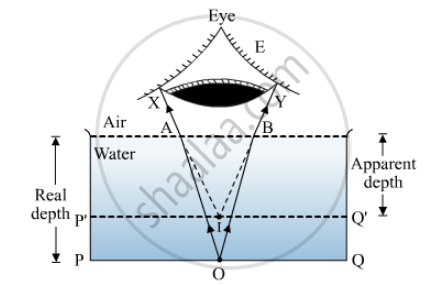Advertisements
Advertisements
Question
With the help of a labelled diagram, explain why a tank full of water appears less deep than it actually is.
Solution
Refraction of light causes a tank full of water to appear less deep than it actually is.
Suppose, we have a tank of water as shown in the following figure.

Here, we take a point O at the bottom of the tank. We see this point because of the light rays coming from it. Now, a light ray OA from point O passes through water and enters air at point A. It gets refracted away from the normal in the direction AX. Similarly, another ray OB gets refracted at point B and bends away from the normal in the direction BY. These two refracted rays, i.e., AX and BY, meet at point I on producing them backwards. This point I (nearer to the water surface than O) is the image of point O.
Therefore, point O appears to be nearer at position I. Similarly, this can be applied to all points on the bottom of the tank. This causes the tank to appear less deep than it actually is.
APPEARS IN
RELATED QUESTIONS
Which type of reflection of light leads to the formation of images?
An object is placed 20 cm in front of a plane mirror. The mirror is moved 2 cm towards the object. The distance between the positions of the positions of the original and final images seen in the mirror is ______.
If a ray of light goes form a denser medium to a rarer medium, will it bend towards the normal or away from the normal?
Why does a ray of light bend when it travels from one medium to another?
A vertical ray of light strikes the horizontal surface of some water:
What is the angle of refraction?
The depth of a pond when seen from above appears to be less.
Water is optically .......... than air.
Fill in the blank and Explain the completed sentences.
The change in ______ of light rays while going from one medium to another is called refraction.
Light changes its direction when going from one transparent medium to another transparent medium. This is called _______.
Why a pencil partly immersed in water appears to be bent at the water surface.
